In my file
LogicApp.parameters.json
I've declared the extra parameter called MyFirstNewParameter
full file contents below
{
"$schema": "https://schema.management.azure.com/schemas/2015-01-01/deploymentParameters.json#",
"contentVersion": "1.0.0.0",
"parameters": {
"logicAppName": {
"value": "MyFirstLogicAppOne"
},
"servicebus_1_connectionString": {
"value": "Endpoint=sb://notForYouToSee"
},
"MyFirstNewParameter": {
"value": "abc123"
}
}
}
In my LogicApp.json file, I've added the "declaration" of MyFirstNewParameter.
in the
"parameters": {}
area (4th line below is where that section starts)
And I've also added a simple response that tries to read the parameter value and send it back in the response. (Named "Read_And_Use_Parameter_Value_Simple_Response" of all things)
{
"$schema": "https://schema.management.azure.com/schemas/2015-01-01/deploymentTemplate.json#",
"contentVersion": "1.0.0.0",
"parameters": {
"logicAppName": {
"type": "string",
"minLength": 1,
"maxLength": 80,
"metadata": {
"description": "Name of the Logic App."
}
},
"logicAppLocation": {
"type": "string",
"defaultValue": "[resourceGroup().location]",
"allowedValues": [
"eastasia",
"southeastasia",
"centralus",
"eastus",
"eastus2",
"westus",
"northcentralus",
"southcentralus",
"northeurope",
"westeurope",
"japanwest",
"japaneast",
"brazilsouth",
"australiaeast",
"australiasoutheast",
"southindia",
"centralindia",
"westindia",
"canadacentral",
"canadaeast",
"uksouth",
"ukwest",
"westcentralus",
"westus2",
"[resourceGroup().location]"
],
"metadata": {
"description": "Location of the Logic App."
}
},
"MyFirstNewParameter": {
"type": "string",
"metadata": {
"description": "Name of the MyFirstNewParameter."
},
"defaultValue": "My1NewParameterDefaultValue"
}
},
"variables": {},
"resources": [
{
"name": "[parameters('logicAppName')]",
"type": "Microsoft.Logic/workflows",
"location": "[parameters('logicAppLocation')]",
"tags": {
"displayName": "LogicApp"
},
"apiVersion": "2016-06-01",
"properties": {
"definition": {
"$schema": "https://schema.management.azure.com/providers/Microsoft.Logic/schemas/2016-06-01/workflowdefinition.json#",
"actions": {
"Read_And_Use_Parameter_Value_Simple_Response": {
"type": "Response",
"inputs": {
"statusCode": 200,
"body": "The parameter value is ***@{parameters('MyFirstNewParameter')}***"
},
"runAfter": {}
}
},
"parameters": {},
"triggers": {
"manual": {
"type": "Request",
"kind": "Http",
"inputs": {
"schema": {}
}
}
},
"contentVersion": "1.0.0.0",
"outputs": {}
},
"parameters": {}
}
}
],
"outputs": {}
}
When I sent a request I get the below in the client:
{
"error": {
"code": "NoResponse",
"message": "The server did not received a response from an upstream server. Request tracking id '000000000000000000000'."
}
}
When I check the portal, the following error is generated:
InvalidTemplate. Unable to process template language expressions in action 'Read_And_Use_Parameter_Value_Simple_Response' inputs at line '1' and column '1232': 'The workflow parameter 'MyFirstNewParameter' is not found.'.
Do what?
How do I "read" parameters defined in LogicApp.parameters.json in the Logic App?
Urls of interest
APPEND WITH WORKING CORRECTLY CODE
The accepted answer shows there is ambiguity with the sets of parameters.
Here is the corrected working answer with un-ambiguous names.
{
"$schema": "https://schema.management.azure.com/schemas/2015-01-01/deploymentParameters.json#",
"contentVersion": "1.0.0.0",
"parameters": {
"logicAppName": {
"value": "MylogicAppName"
},
"MyFirstNewArmParameter": {
"value": "ValueIWantToSeeShowUp"
}
}
}
and
{
"$schema": "https://schema.management.azure.com/schemas/2015-01-01/deploymentTemplate.json#",
"contentVersion": "1.0.0.0",
"parameters": {
"logicAppName": {
"type": "string",
"minLength": 1,
"maxLength": 80,
"metadata": {
"description": "Name of the Logic App."
}
},
"logicAppLocation": {
"type": "string",
"defaultValue": "[resourceGroup().location]",
"allowedValues": [
"eastasia",
"southeastasia",
"centralus",
"eastus",
"eastus2",
"westus",
"northcentralus",
"southcentralus",
"northeurope",
"westeurope",
"japanwest",
"japaneast",
"brazilsouth",
"australiaeast",
"australiasoutheast",
"southindia",
"centralindia",
"westindia",
"canadacentral",
"canadaeast",
"uksouth",
"ukwest",
"westcentralus",
"westus2",
"[resourceGroup().location]"
],
"metadata": {
"description": "Location of the Logic App."
}
},
"MyFirstNewArmParameter": {
"type": "string",
"metadata": {
"description": "Name of the MyFirstNewArmParameter."
},
"defaultValue": "My1NewArmParameterDefaultValue"
}
},
"variables": {
},
"resources": [{
"name": "[parameters('logicAppName')]",
"type": "Microsoft.Logic/workflows",
"location": "[parameters('logicAppLocation')]",
"tags": {
"displayName": "LogicApp"
},
"apiVersion": "2016-06-01",
"properties": {
"definition": {
"$schema": "https://schema.management.azure.com/providers/Microsoft.Logic/schemas/2016-06-01/workflowdefinition.json#",
"actions": {
"Read_And_Use_Parameter_Value_Simple_Response": {
"type": "Response",
"inputs": {
"statusCode": 200,
"body": "The parameter value is ***@{parameters('MyFirstNewLogicAppParameter')}***"
},
"runAfter": {
}
}
},
"parameters": {
"MyFirstNewLogicAppParameter": {
"type": "string",
"defaultValue": "MyFirstNewLogicAppParameterDefaultValue"
}
},
"triggers": {
"manual": {
"type": "Request",
"kind": "Http",
"inputs": {
"schema": {
}
}
}
},
"contentVersion": "1.0.0.0",
"outputs": {
}
},
"parameters": {
"MyFirstNewLogicAppParameter": {
"value": "[parameters('MyFirstNewArmParameter')]"
}
}
}
}],
"outputs": {
}
}
The client now receives the anticipated value
**The parameter value is ***ValueIWantToSeeShowUp*****
I also found this article:
http://blog.ibiz-solutions.se/integration/logic-apps-parameters-vs-arm-parameters/
The first paragraph of the articles is below, in case the url stops working in the future (to maybe internet-search if it gets moved)
Logic Apps Parameters vs ARM Parameters I got the question about what the difference is between ARM template parameters and Logic App parameters and when these should be used, so that is what I’ll try to explain in this post. First of ARM template paramters are used with ARM templates and the ARM template is used when deploying ARM based resources to Azure and Logic App’s is a resource that is deployed via ARM templates. The workflow definition language behind Logic App’s is very similar to ARM templates and therefore it can be tricky to see the difference in the beginning.
Author: Mattias Lögdberg
